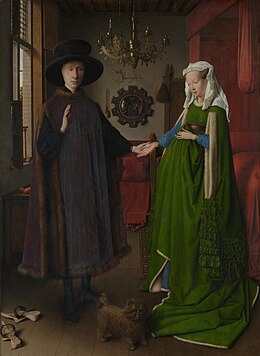Jan van Eyck
Jan van Eyck (Belanda: [ˈjɑn fɑn ˈɛik]) (sebelum c. 1390 – 9 Juli 1441) adalah seorang pelukis Netherlandish awal yang aktif di Brugge dan salah satu seniman Renaisans Utara yang paling signifikan dari abad ke-15. Beberapa catatan yang masih ada dari kehidupan awalnya menunjukkan bahwa ia lahir c. 1380–1390, kemungkinan besar di Maaseik. Dia mengambil pekerjaan di Den Haag sebagai pelukis dan Valet de chambre dengan John III yang Kejam, penguasa Holandia dan Hainaut di Den Haag sekitar tahun 1422, ketika ia sudah menjadi pelukis master dengan asisten lokakarya. Setelah kematian John pada 1425 ia bekerja di Lille sebagai pelukis istana untuk Philippe yang Baik, Adipati Bourgogne, sampai tahun 1429 sebelum pindah ke Bruges, di mana dia tinggal sampai kematiannya. Dia sangat dihormati oleh Philippe, dan melakukan sejumlah kunjungan diplomatik ke luar negeri, termasuk ke Lisboa tahun 1428 untuk mengeksplorasi kemungkinan kontrak pernikahan antara adipati dan Isabella dari Portugal.


Terlepas dari Ghent Altarpiece dan miniatur diiluminasi dari Turin-Milan Hours, sekitar 20 lukisan yang masih bertahan dapat dengan pasti diatribusikan dengannya, semua tertanggal antara tahun 1432 dan 1439. Sepuluh, termasuk Ghent altarpiece,[A] tertanggal dan ditandatangani dengan variasi dari mottonya, ALS IK KAN (seperti yang saya (Eyck) bisa) selalu ditulis dalam huruf Yunani, selalu merupakan permainan kata pada namanya.
Van Eyck melukis baik materi subyek sekuler dan religius, termasuk altarpiece, tokoh agama panel tunggal dan potret yang ditugaskan. Karyanya termasuk panel tunggal, diptych,[1] triptych, dan panel polyptych. Dia dibayar dengan baik oleh Philippe, yang menginginkan bahwa pelukisnya aman secara finansial dan memiliki kebebasan artistik dan bisa melukis "setiap kali dia senang".[2] Karya van Eyck berasal dari gaya Gothik Internasional, tapi ia segera menenggelamkannya, sebagian melalui penekanan yang lebih besar pada naturalisme dan realisme. Melalui perkembangan dalam penggunaan cat minyak ia mencapai tingkat keahlian yang baru.[3] Van Eyck sangat berpengaruh dan teknik dan gayanya diadopsi dan disempurnakan oleh pelukis Netherlandish Awal.
Catatan kaki
- ^ In 1998 Holland Cotter estimated "only two dozen or so paintings...attributed...with varying degrees of confidence, along with some drawings and a few pages from...the Turin-Milan Hours". See Mysteries in the Crystalline World of a Flemish Master, 24 April 1998. There is a complex relationship and tension between art historians and holding museums in assigning authorship. Of the 40 or so works considered originals in the mid 80s, around ten are now vigorously contested by leading researchers as workshop
Catatan
Sumber
- Ainsworth, Maryan; Christiansen, Keith (eds). From Van Eyck to Bruegel Early Netherlandish Painting in The Metropolitan Museum of Art. New York: Metropolitan Museum of Art, 1998. ISBN 0-300-08609-1
- Bauman, Guy. "Early Flemish Poertaits, 1425–1525". Metropolitan Museum of Art Bulletin, vol 43, no. 4, Spring, 1986
- Borchert, Till-Holger. Van Eyck. London: Taschen, 2008. ISBN 3-8228-5687-8
- Borchert, Till-Holger (ed). Age of Van Eyck: The Mediterranean World and Early Netherlandish Painting. Groeningemuseum, Stedelijke Musea Brugge, 2002
- Borchert, Till-Holger. Van Eyck to Durer. London: Thames & Hudson, 2011. ISBN 978-0-500-23883-7
- Campbell, Lorne. The Fifteenth Century Netherlandish Schools. London: National Gallery Publications, 1998. ISBN 1-85709-171-X
- Chilvers, Ian. The Oxford Dictionary of Art. Oxford: Oxford University Press, 2004. ISBN 0-19-860476-9
- Dhanens, Elisabeth. Hubert & Jan Van Eyck. Tabard Press, 1980. ISBN 978-0914427001
- Ferrari, Simone. Van Eyck: Masters of Art. Munich: Prestel, 2013. ISBN 3-7913-4826-4
- Foister, Susan, Sue Jones and Delphine Cool (eds). Investigating Jan van Eyck. Turnhout: Brepols, 2000
- Friedländer, Max J. Early Netherlandish Painting. Leiden: Praeger, 1967–1976. ASIN B0006BQGOW
- Graham, Jenny. Inventing van Eyck: The remaking of an artist for the modern age. Oxford and New York: Berg, 2007
- Harbison, Craig. Jan van Eyck: The Play of Realism. Edinburgh: Reaktion Books, 1997. ISBN 0-948462-79-5
- Harbison, Craig. "Realism and Symbolism in Early Flemish Painting". The Art Bulletin, Volume 66, No. 4, December, 1984
- Jones, Susan Frances. Van Eyck to Gossaert. National Gallery, 2011. ISBN 978-1-85709-504-3
- Kemperdick, Stephan. The Early Portrait, from the Collection of the Prince of Liechtenstein and the Kunstmuseum Basel. Munich: Prestel, 2006. ISBN 3-7913-3598-7
- Koerner, Joseph Leo. The moment of self-portraiture in German Renaissance art. Chicago: University of Chicago Press, 1996. ISBN 0-226-44999-8
- Kren, Thomas; McKendrick, Scott (eds). Illuminating the Renaissance: The Triumph of Flemish Manuscript Painting in Europe. Los Angeles: Getty Museum/Royal Academy of Arts, 2003. ISBN 1-903973-28-7
- Macfall, Haldane. "A History of Painting: The Renaissance in the North and the Flemish Genius Part Four". Whitefish, Montana: Kessinger Publishing, 2004. 15. ISBN 1-4179-4509-5
- Nash, Susie. Northern Renaissance art. Oxford: Oxford University Press, 2008. ISBN 0-19-284269-2
- Pächt, Otto. Van Eyck and the Founders of Early Netherlandish Painting. New York: Harvey Miller, 1994. ISBN 1-872501-81-8
- Panofsky, Erwin. Early Netherlandish Painting. London: Harper Collins, 1971. ISBN 0-06-430002-1
- Philips, Lotte B. "The Ghent Altarpiece and the Art of Jan van Eyck". Princeton: Princeton University Press, 1971. ISBN 0-691-03870-8
- Seidel, Linda. "The Value of Verisimilitude in the Art of Jan Van Eyck". "Yale French Studies"; Contexts: Style and Values in Medieval Art and Literature, 1991
- Smith, Jeffrey. The Northern Renaissance (Art and Ideas). London: Phaidon Press, 2004. ISBN 0-7148-3867-5
- Van Der Elst, Joseph. "The Last Flowering of the Middle Ages". Whitefish, Montana: Kessinger Publishing, 2005. ISBN 1-4191-3806-5
- Ward, John. "Disguised Symbolism as Enactive Symbolism in Van Eyck's Paintings". Artibus et Historiae, Volume 15, No. 29, 1994
- Wolff, Martha; Hand, John Oliver. Early Netherlandish painting. Washington: National Gallery of Art, 1987. ISBN 0-521-34016-0
Pranala luar
- Jan van Eyck Gallery at MuseumSyndicate
- Closer to Van Eyck (The Ghent Altarpiece in 100 billion pixels)
- Jan Van Eyck in BALaT - Belgian Art Links and Tools (KIK-IRPA, Brussels)
- Petrus Christus: Renaissance master of Bruges, a full text exhibition catalog from The Metropolitan Museum of Art, which contains lengthy discussions of Jan van Eyck
- The Renaissance in the North, a full text exhibition catalog from The Metropolitan Museum of Art, which contains lengthy discussions of Jan van Eyck